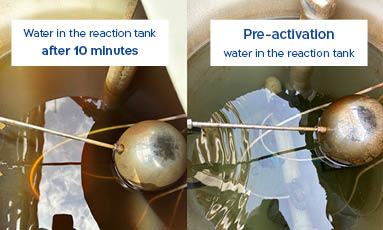Removal of Dissolved Iron and Manganese from Groundwater Using Ozone Nanobubbles
In this project, floating nano-ozone bubble technology was used as a cost-effective, efficient, and environmentally friendly solution for treating water containing high concentrations of dissolved iron and manganese.

Project ID
Location
Chemical industry in IsraelSystem
Application
Type
Nanobubble system with a nanobubble reactor, ozone generator, and sand filtration unitYear
2024Many groundwater sources contain high concentrations of dissolved iron and manganese, which exceed regulatory standards and may cause aesthetic issues, undesirable taste and odor, and clogging of pipes and water systems. Traditional oxidation methods require longer reaction times, larger footprints, and are not always effective in removing dissolved metals.
The plant sources its water from an on-site well. The well water contains contaminants, mainly iron and manganese at high concentrations (1–4 mg/L), which disrupt the plant’s production processes. Therefore, treatment is required to reduce these concentrations to minimal levels.
Ozone nanobubbles enable a fast and efficient increase of dissolved ozone concentration in the water. This process rapidly oxidizes the dissolved iron and manganese, transforming them into insoluble oxides that can be easily removed using sand filtration. Additionally, since ozone naturally decomposes into oxygen, the method is considered environmentally friendly and cleaner compared to other oxidation techniques.
After only 10 minutes of treatment with ozone nanobubbles, the concentration of iron and manganese in the water significantly decreased. Samples taken from the groundwater before and after treatment showed a noticeable improvement in transparency and water quality. Following the filtration stage, iron and manganese were almost completely removed.

